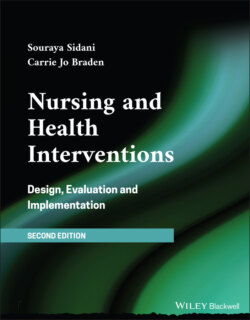Читать книгу Nursing and Health Interventions - Souraya Sidani - Страница 12
CHAPTER 1 Introduction to Intervention Research
ОглавлениеClients experience health problems and seek assistance from health professionals to address these problems. Health professionals are responsible for providing high‐quality healthcare that successfully manages the clients' problems and promotes their well‐being. Specifically, health professionals are expected to engage with clients in making treatment‐related decisions; provide the selected treatment or intervention; monitor clients' responses to treatment, that is, changes in the experience of the health problems; and adapt the intervention, as needed, to clients' responses. Thus, interventions constitute the central elements of healthcare, and their careful selection and appropriate delivery form the basis of high‐quality care. Sound decision‐making demands that health professionals: are aware of available interventions addressing the health problem with which clients present and of evidence regarding the benefits or effectiveness and the risks or discomfort associated with alternative interventions; inquire about clients' values and preferences; and collaboratively choose the intervention that is beneficial yet consistent with clients' values and preferences. Intervention research is concerned with generating evidence on the benefits and risks of health interventions, to inform treatment decision‐making in practice.
What constitutes empirical evidence that is useful in informing treatment decisions in practice is evolving. With the adoption of evidence‐based practice in the early 1990s, evidence from randomized controlled or clinical trials (RCTs), also known as experimental designs, was admitted as the most reliable or robust evidence of health interventions' benefits; the RCT is believed to have features that enhance the validity of inferences regarding the causal impact of interventions on outcomes (Holm et al., 2017). Consequently, evidence synthesized across RCTs was relied on to generate guidelines that inform decision‐making in practice.
In the past decades, experiences with evidence‐based practice revealed limitations of this approach to healthcare (Horwitz et al., 2017). These limitations, along with increasing societal value and demand for person‐centeredness, are contributing to shifts in perspectives on what constitutes high‐quality healthcare and what methods and strategies are appropriate for the design, delivery, and evaluation of interventions.
In this chapter, the treatment decision‐making steps and the information needed to guide decision‐making in practice are briefly reviewed. Limitations of evidence derived from RCTs in informing decision‐making in practice are highlighted and related to disregarding the principles of client‐centeredness and the complexity of the real world. Advances in research methodology that account for complexity are introduced. The overall process for designing, delivering, and evaluating interventions, and implementing them in practice, is briefly described.
